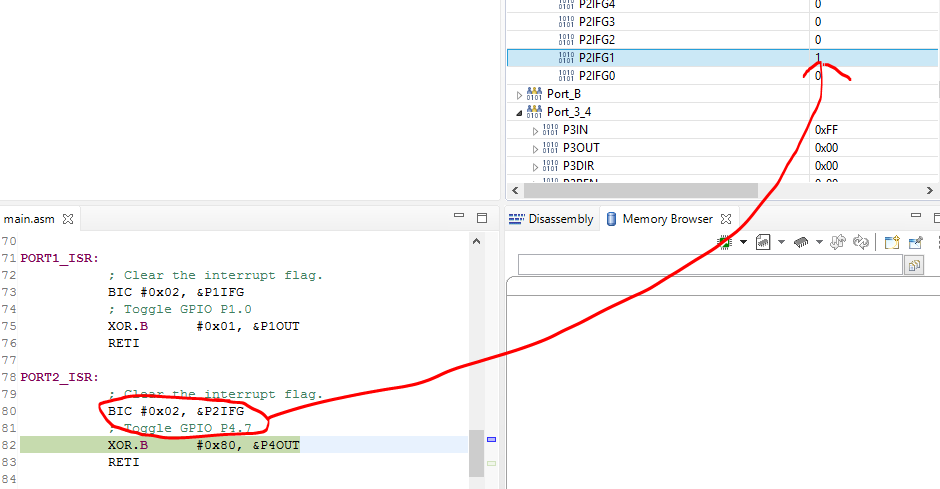Other Parts Discussed in Thread: MSP-EXP430F5529LP
Hello All, I am new to embedded programming. I started with MSP-EXP430F5529LP and tried to follow a great blog series https://embedded.fm/blog/ese101 by Chris Svec
In one of his blogs (https://embedded.fm/blog/ese101-interrupts-blink), the author was using ISR (trigger by a push buttom switch GPIO 1.1) to blink a LED (GPIO 1.0). I follow what he did successfully and then I wanted to create another ISR to use another push buttom switch (GPIO 2.1) to blink another LED (GPIO 4.7).
Following is my code in assembly:
;------------------------------------------------------------------------------- ; Main loop here ;------------------------------------------------------------------------------- ; Set GPIO P1.0 to be an output (P1DIR bit 0 == 1) BIS.B #0x01, &P1DIR ; Set GPIO P1.1 to be an input (P1DIR bit 1 == 0) BIC.B #0x02, &P1DIR ; Set GPIO P1.1 to be pulled up or down (P1REN bit 1 == 1) BIS.B #0x02, &P1REN ; Set GPIO P1.1 as a pull-up resistor (P1OUT bit 1 == 1) BIS.B #0x02, &P1OUT ; Set interrupt on high-to-low transition of P1.1 BIS.B #0x02, &P1IES ; Clear any interrupts that happened when changing P1IES BIC.B #0x02, &P1IFG ; Enable P1.1 interrupts BIS.B #0x02, &P1IE ;------------------------------------------------------------------------------- ; Set GPIO P4.7 to be an output (P4DIR bit 7 == 1) BIS.B #0x80, &P4DIR ; Set GPIO P2.1 to be an input (P2DIR bit 1 == 0) BIC.B #0x02, &P2DIR ; Set GPIO P2.1 to be pulled up or down (P2REN bit 1 == 1) BIS.B #0x02, &P2REN ; Set GPIO P2.1 as a pull-up resistor (P2OUT bit 1 == 1) BIS.B #0x02, &P2OUT ; Set interrupt on high-to-low transition of P2.1 BIS.B #0x02, &P2IES ; Clear any interrupts that happened when changing P2IES BIC.B #0x02, &P2IFG ; Enable P2.1 interrupts BIS.B #0x02, &P2IE ; Enable interrupts NOP ; the user’s guide recommends a NOP before setting #GIE BIS #GIE, SR NOP ; the user’s guide recommends a NOP after setting #GIE BIC.W #0x01, &P1OUT BIC.W #0x80, &P4OUT MainLoop: ; infinite loop that does nothing JMP MainLoop NOP PORT1_ISR: ; Clear the interrupt flag. BIC #0x02, &P1IFG ; Toggle GPIO P1.0 XOR.B #0x01, &P1OUT RETI PORT2_ISR: ; Clear the interrupt flag. BIC #0x02, &P2IFG ; Toggle GPIO P4.7 XOR.B #0x80, &P4OUT RETI ;------------------------------------------------------------------------------- ; Stack Pointer definition ;------------------------------------------------------------------------------- .global __STACK_END .sect .stack ;------------------------------------------------------------------------------- ; Interrupt Vectors ;------------------------------------------------------------------------------- .sect ".reset" ; MSP430 RESET Vector .short RESET .sect ".int47" ; We added these two lines .short PORT1_ISR ; for configuring our GPIO Port P1 ISR. .sect ".int42" .short PORT2_ISR
When I run my code on the eval board, it works flawlessly for PORT1_ISR:. ISR PORT1_ISR: is executed when GPIO 1.1 is engaged. It returns to the MainLoop after ISR finishes. However, when I tried PORT2_ISR, GPIO 2.1 triggered the ISR, but upon finishing, it didn't return to the MainLoop. Instead, it keeps looping in this ISR indefinitely. Is there something I did wrong here?
Thanks
Yi


